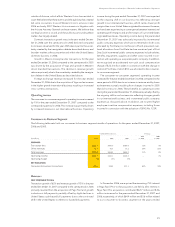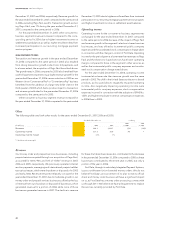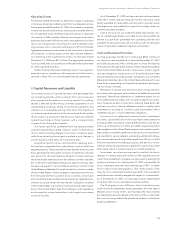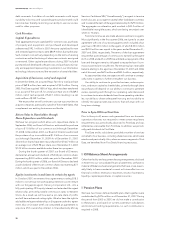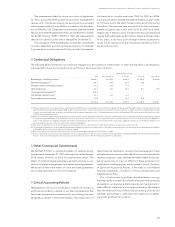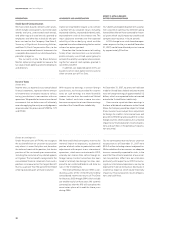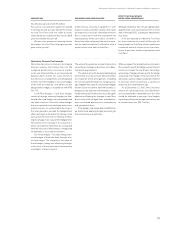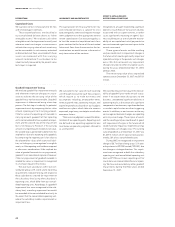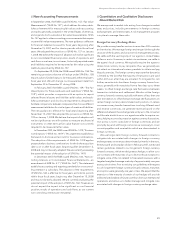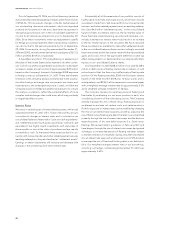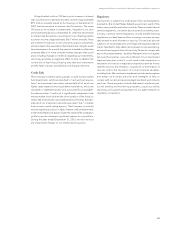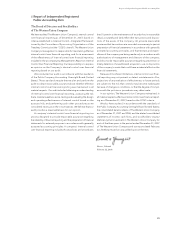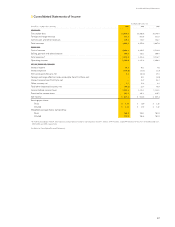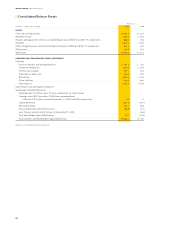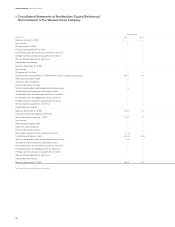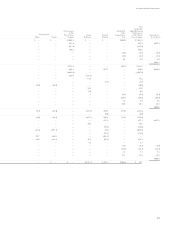Western Union 2007 Annual Report Download - page 43
Download and view the complete annual report
Please find page 43 of the 2007 Western Union annual report below. You can navigate through the pages in the report by either clicking on the pages listed below, or by using the keyword search tool below to find specific information within the annual report.Management’s Discussion and Analysis of Financial Condition and Results of Operations
41
||
New Accounting Pronouncements
In September 2006, the FASB issued SFAS No. 157, “Fair Value
Measurements” (“SFAS No. 157”), which defi nes fair value, estab-
lishes a framework for measuring fair value under accounting
principles generally accepted in the United States of America,
and expands disclosures about fair value measurements. SFAS
No. 157 applies to other accounting pronouncements that require
or permit fair value measurements. The new guidance is effective
for fi nancial statements issued for fi scal years beginning after
November 15, 2007, and for interim periods within those fi scal
years. We adopted the provisions of SFAS No. 157 on January
1, 2008. We believe the impact of adoption will not be signifi cant
to our consolidated fi nancial position, results of operations and
cash fl ows as we have, in most cases, historically reported assets
and liabilities required to be reported at fair value using the
methods prescribed by SFAS No. 157.
On September 29, 2006, the FASB issued SFAS No. 158. The
remaining provisions that we will adopt under SFAS No. 158
require a plan’s funded status to be measured at the employer’s
fi scal year end. We will change our measurement date from
September 30 to December 31 during 2008.
In February 2007, the FASB issued SFAS No. 159, “The Fair
Value Option for Financial Assets and Liabilities” (“SFAS No.
159”), which provides companies with an option to report
selected fi nancial assets and liabilities at fair value, and estab-
lishes presentation and disclosure requirements designed to
facilitate comparisons between companies that choose different
measurement attributes for similar types of assets and liabilities.
The new guidance is effective for fi scal years beginning after
November 15, 2007. We adopted the provisions of SFAS No.
159 on January 1, 2008. We believe the impact of adoption will
not be signifi cant as we will not elect to measure any fi nancial
instruments or other items at fair value that are not currently
required to be measured at fair value.
In December 2007, the FASB issued SFAS No. 141R, “Business
Combinations” (“SFAS No. 141R”). This statement establishes a
framework to disclose and account for business combinations.
The adoption of the requirements of SFAS No. 141R applies
prospectively to business combinations for which the acquisition
date is on or after fi scal years beginning after December 15,
2008 and may not be early adopted. We are currently evaluating
the potential impact of the adoption of SFAS No. 141R.
In December 2007, the FASB issued SFAS No. 160, “Noncon-
trolling Interests in Consolidated Financial Statements — an
amendment of ARB No. 51” (“SFAS No. 160”). The statement
establishes accounting and reporting standards for a noncontrol-
ling interest in a subsidiary. The adoption of the requirements
of SFAS No. 160 is effective for fi scal years and interim periods
within those fi scal years, beginning after December 15, 2008
and may not be early adopted. We are currently evaluating the
potential impact of the adoption of SFAS No. 160. However, we
do not expect the impact to be significant on our financial
position, results of operations and cash fl ows, as our current
non-controlling interests are immaterial.
||
Quantitative and Qualitative Disclosures
About Market Risk
We are exposed to market risks arising from changes in market
rates and prices, including movements in foreign currency
exchange rates and interest rates. A risk management program
is in place to manage these risks.
Foreign Currency Exchange Rates
We provide money transfer services in more than 200 countries
and territories. We manage foreign exchange risk through the
structure of the business and an active risk management process.
We settle with the vast majority of our agents in United States
dollars or euros. However, in certain circumstances, we settle in
the agent’s local currency. We typically require the agent to
obtain local currency to pay recipients; thus, we generally are
not reliant on international currency markets to obtain and pay
illiquid currencies. The foreign currency exposure that does exist
is limited by the fact that the majority of transactions are paid
within 24 hours after they are initiated. To mitigate this risk
further, we enter into short-term foreign currency forward con-
tracts, generally with maturities from a few days up to three
weeks, to offset foreign exchange rate fl uctuations between
transaction initiation and settlement. We also utilize foreign
currency forward contracts, typically with terms of less than one
year at inception, to offset foreign exchange rate fl uctuations on
certain foreign currency denominated cash positions. In certain
consumer money transfer transactions involving different send
and receive currencies, we generate revenue based on the
difference between the exchange rate set by us to the consumer
and the rate at which we or our agents are able to acquire cur-
rency, helping to provide protection against currency fl uctuations.
Our policy is not to speculate in foreign currencies and we
promptly buy and sell foreign currencies as necessary to cover
our net payables and receivables which are denominated in
foreign currencies.
We use longer-term foreign currency forward contracts to
mitigate risks associated with changes in foreign currency
exchange rates on revenues denominated primarily in the euro,
British pound and Canadian dollar. In February 2007, we revised
certain guidelines related to our longer-term foreign currency
forward contracts, which we designate as hedges, to allow us to
use contracts with maturities of up to 36 months at inception to
mitigate some of the risk related to forecasted revenues, with a
targeted weighted-average maturity of approximately one year
at any point in time. Prior to revising our guidelines with respect
to such longer-term foreign currency forward contracts, maturities
at inception were generally one year or less. We expect that the
extension of the maturity of certain of our hedges will provide
additional predictability of future cash fl ows from our international
operations and allow us to better manage and mitigate risks
associated with changes in foreign currency exchange rates.


